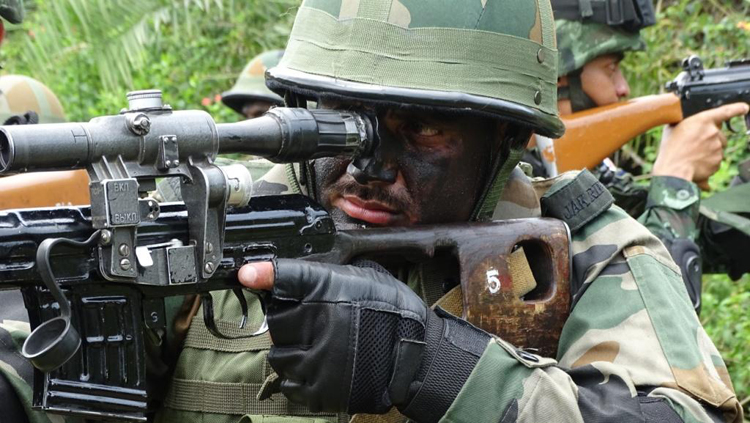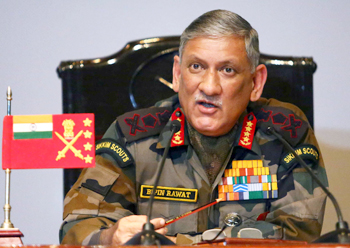INDIAN ARMED FORCES CHIEFS ON
OUR RELENTLESS AND FOCUSED PUBLISHING EFFORTS

SP Guide Publications puts forth a well compiled articulation of issues, pursuits and accomplishments of the Indian Army, over the years

I am confident that SP Guide Publications would continue to inform, inspire and influence.

My compliments to SP Guide Publications for informative and credible reportage on contemporary aerospace issues over the past six decades.
- Prime Minister witnesses 'Bharat Shakti' – a Tri-Services Firing and Manoeuvre Exercise in Pokhran, Rajasthan
- Interim Defence Budget 2024-25 — An Analysis
- Union Defence budget 2024
- Indian Army: In quest of greater firepower and policy recommendations for gaps
- Indian Army Annual Press Conference 2024
- 6G will transform military-industrial applications
Army to get modern rifles; now 'Make' procedure is open to Start-ups
By approving fast track purchase of modern guns for equipping the troops at frontline, DAC has initiated the much awaited modernization of Indian soldiers and by relaxing the norms it also opened the 'Make II' procedure to startups.

Ministry of Defence, on January 16, cleared proposal for purchase of limited number of assault rifle (AR) and carbine and also eased the participation criteria for Indian industry in 'Make II' procedure.
Minister of Defence Nirmala Sitharaman led Defence Acquisition Council (DAC), top purchase body of Ministry of Defence, cleared proposal for "procurement of 72,400 assault rifles and 93,895 carbines on fast track basis for 3,547 crore to enable the Defence Forces to meet their immediate requirement for the troops deployed on the borders."
More than million soldiers of Indian army need replacement of indigenous INSAS (Indian Small Arms System) rifles designed and developed by DRDO and manufactured by Ordinance factory, which have received fair share of criticism from forces, with modern more reliable rifles. In addition to the AR, army also needs more accurate close quarter battle carbines for counter insurgency operations. Currently, they are using Russian Ak-47/56 for anti terror operations in Jammu and Kashmir and North East.
There has been rethinking within the army over the AR's caliber after using the INSAS with 5.56x45 mm, army has now decided to go for a bigger caliber rifles of 7.6x51 mm for more effective fire power. Army needs in excess of a three lakhs modern carbine for operational needs.

In his annual press conference, on January 12, Army Chief Bipin Rawat had said that the Army will have two kinds of ARs. "The hi-tech rifles, for instance, will be only for infantry battalions deployed on the front. The bulk of the weapons will have to come through the indigenous route, the ordnance factories or the private industry," General Rawat said.
In order to "encourage participation of private sector in defence design and production and to give a boost to 'Make in India' programme," DAC approved "significant changes in the 'Make II' category of the Defence Procurement Procedure."
Since, Make II procedure do not involve any government funding, the council has made it more industry friendly by allowing the MoD to "accept suo-motu proposals from the industry and also allows start-ups to develop equipment for Indian Armed Forces."
For Make II procedure, DAC has done away with the requirement of credit rating, submission of detailed project report and reduced the financial net worth of the participant companies. In addition, DAC has allowed all vendors to participate in the prototype development process. Earlier, only two shortlisted companies would develop prototype equipment.
DAC cleared proposal for "procurement of 72,400 assault rifles and 93,895 carbines on fast track basis for 3,547 crore to enable the Defence Forces to meet their immediate requirement for the troops deployed on the borders."
The DAC will now only accord approval of the Make II project, "all clearances will be accorded at Service HQ (SHQ) level."
To this effect, SHQ will setup project facilitation teams, as an industry-service interface, at the development stage.
Services would provide technical inputs, trial infrastructure and other facilities as required by the vendor.
The SHQ has been empowered to accept and process the development even under single vendor situation and to hire domain experts from private sector. In the new format, projects will not be foreclosed after the project is sanctioned except on default by the vendor.
These changes can initiate innovative proposals for the challenges faced by Indian forces.





